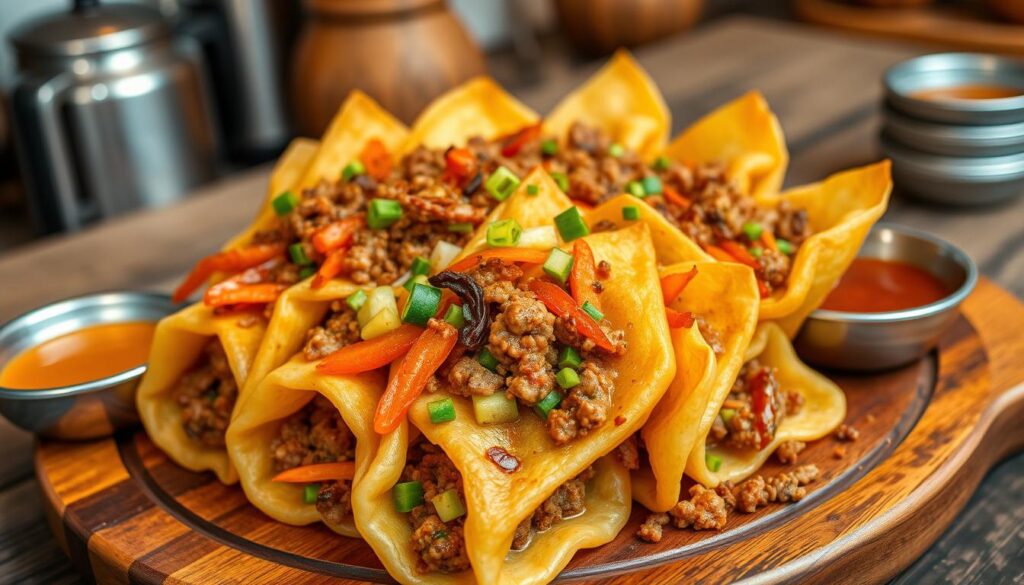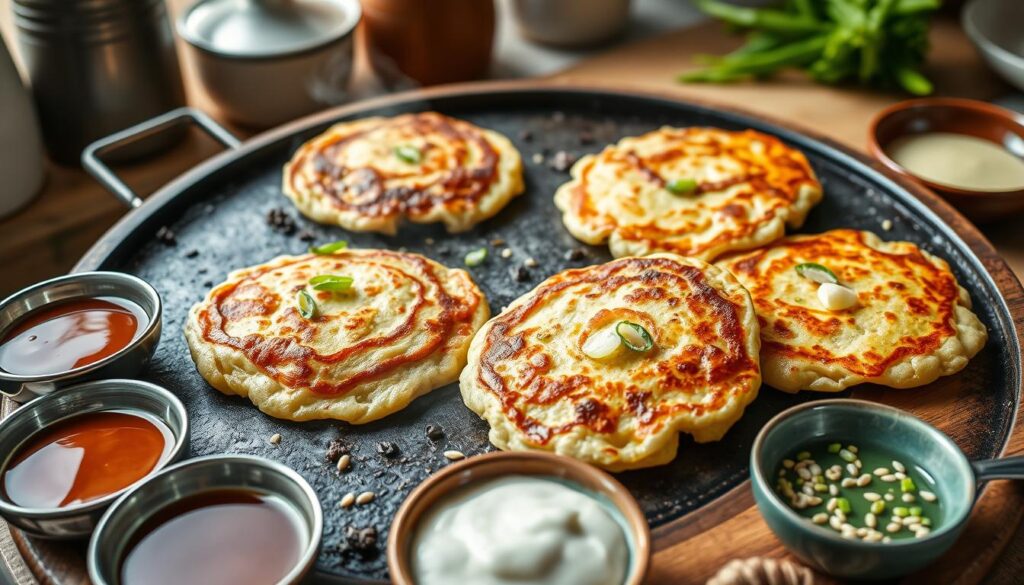Pancakes Korean are a delicious part of Korean cuisine, especially the savory variety known as Hotteok. This traditional street food has won the hearts of many, combining ancient traditions with modern twists. In this guide, we’ll cover its origins, cultural importance, and different regional flavors. Plus, we’ll share tips on making perfect savory Hotteok at home.
Key Takeaways
- Explore the cultural heritage and evolution of traditional Korean Hotteok
- Uncover the essential ingredients and techniques for creating authentic savory pancakes
- Discover popular fillings and flavor combinations to elevate your Hotteok experience
- Master the art of cooking Hotteok to achieve a crispy exterior and delicious interior
- Learn to troubleshoot common dough issues and achieve the perfect texture
What Is Hotteok? The Origins and Cultural Significance of Korean Pancakes
Hotteok, a favorite Korean pancake, has a deep history in the country’s lively food scene. It started as a street food and has grown, showing the changing face of Korean cuisine. What was once a sweet treat now comes in many savory variations, enjoyed by people all over Korea.
Traditional Street Food Heritage
Hotteok’s roots are in Korea’s busy street markets. Vendors sold this soft pancake as a quick snack. The street food tradition is key in Korea, with Hotteok being a favorite that unites people, offering a taste of tradition and ease.
From Sweet to Savory: The Evolution of Korean Pancakes (Hotteok)
The Hotteok recipe has changed, moving from sweet to savory. This change shows how Korean food culture is always evolving. Chefs and home cooks have tried new flavors, meeting the changing tastes of people.
Regional Differences Across Korea
As Hotteok spread across Korea, different regions made their own versions. Each region used its own ingredients and cooking methods. This has created a variety of flavors that highlight the diversity of Korean cuisine.
Essential Ingredients for Authentic Savory Korean Pancakes (Hotteok)
To make the perfect savory Korean pantry staples, you need the right ingredients. The yeast dough is key, giving the savory fillings a soft base. Mix rice flour and all-purpose flour with warm water, yeast, and a bit of sugar.
The savory fillings can be anything you like. Use Korean pantry staples like diced onions, ground pork or beef, shredded cabbage, and spices like garlic, ginger, and scallions. The filling should be savory, slightly sweet, and full of umami to match the dough.
To get the real taste of hotteok, let the yeast dough rest. This step lets the dough relax, making it soft and pliable. It will also puff up nicely when cooked.
Pancakes korean: Mastering the Perfect Dough Texture
Making the perfect dough is key to delicious Korean pancakes, or *hotteok*. To get it right, you need to know how to knead and the role of *fermentation*. This will help you achieve the right *dough consistency* and *pancake texture*.
Proper Kneading Techniques
Kneading is crucial for a great dough. You should knead it until it’s smooth and elastic. This helps the gluten develop, making the dough strong. But, don’t overdo it, or your pancakes might end up tough.
Resting Time and Ideal Temperature for Perfect Korean Pancakes
After kneading, let the dough rest and ferment. This step is important for the *pancake texture*. The right resting time and temperature can make a big difference. Usually, a 30-minute rest at room temperature or a longer chill is best.
Troubleshooting Common Dough Issues
If your dough is too sticky, add a bit more flour while kneading. If it’s too dry, a splash of water can help. Adjusting the rest time and temperature can also fix dough problems.
Mastering dough preparation is essential for perfect Korean pancakes. It ensures your pancakes have the right *pancake texture* and *dough consistency*. This makes for a wonderful eating experience.
Popular Savory Fillings and Combinations for Korean Pancakes (Hotteok)
Korean pancakes, or hotteok, have changed from sweet to savory. They now offer a wide range of fillings. These fillings excite the taste buds and show off the street food’s creativity.
The secret to savory hotteok is Korean spices. Gochujang, a spicy red chili paste, adds flavor and a bit of heat. Soy sauce and garlic bring out the umami. Scallions and ginger add freshness and aroma.
Vegetable fillings are a hit, with cabbage, carrots, and vegetable fillings adding crunch. Cheese, like mozzarella or cheddar, makes the fillings gooey.
For a heartier option, meat fillings like seasoned ground beef, pork, or chicken are favored. These are seasoned with fusion flavors. This mix of Korean spices and global tastes creates unique flavors.

Savory hotteok offers endless possibilities for creative cooks. You can try classic flavors or bold, new ones. There’s a hotteok for every taste.
Step-by-Step Cooking Techniques for Crispy Korean Pancakes (Hotteok)
To get the perfect crispy texture in savory Korean pancakes, called Hotteok, you need to master pan-frying. It’s all about controlling the temperature and flipping right. These steps help create that golden-brown crust everyone loves.
Temperature Control Tips
Getting the cooking temperature just right is key for perfect Hotteok. Heat your pan or griddle to medium-high. The oil should shimmer but not smoke before adding the pancakes. Don’t turn up the heat too high, as it can burn the outside before the inside is cooked.
Keep adjusting the temperature to ensure it stays even. This is the secret to cooking Hotteok evenly.
Flipping Methods
Flipping the Hotteok at the right time is crucial. Wait until the edges start to turn golden and the center sets before flipping. Use a spatula, tongs, or your fingers to flip them gently, without tearing the dough.
A smooth flip is essential for keeping the texture crispy.
Achieving the Golden-Brown Crust
The perfect Hotteok has a crisp, golden-brown outside and a soft inside. To get this, watch the cooking time and temperature closely. Fry the pancakes until they’re a deep, rich color, but don’t overcook them.
The result is a satisfying crunch that goes well with the savory fillings. It makes for a delightful Korean street food experience.
Conclusion
In this guide, we’ve looked into Korean savory pancakes, or Hotteok. They started as a street food loved by many. Now, they come in many savory flavors, enjoyed by people all over.
Learning to make homemade Hotteok lets you enjoy this dish and connect with Korea’s cooking traditions. You’ll need to know the right ingredients, get the dough just right, and try different fillings. This way, you can improve your cooking skills and make Korean street food at home.
Whether you’re an experienced cook or new to Korean food, we invite you to try making Hotteok. Dive into the culture, try different versions, and enjoy the smell of these pancakes. It’s like stepping into Korea’s lively streets. Bon appétit!

